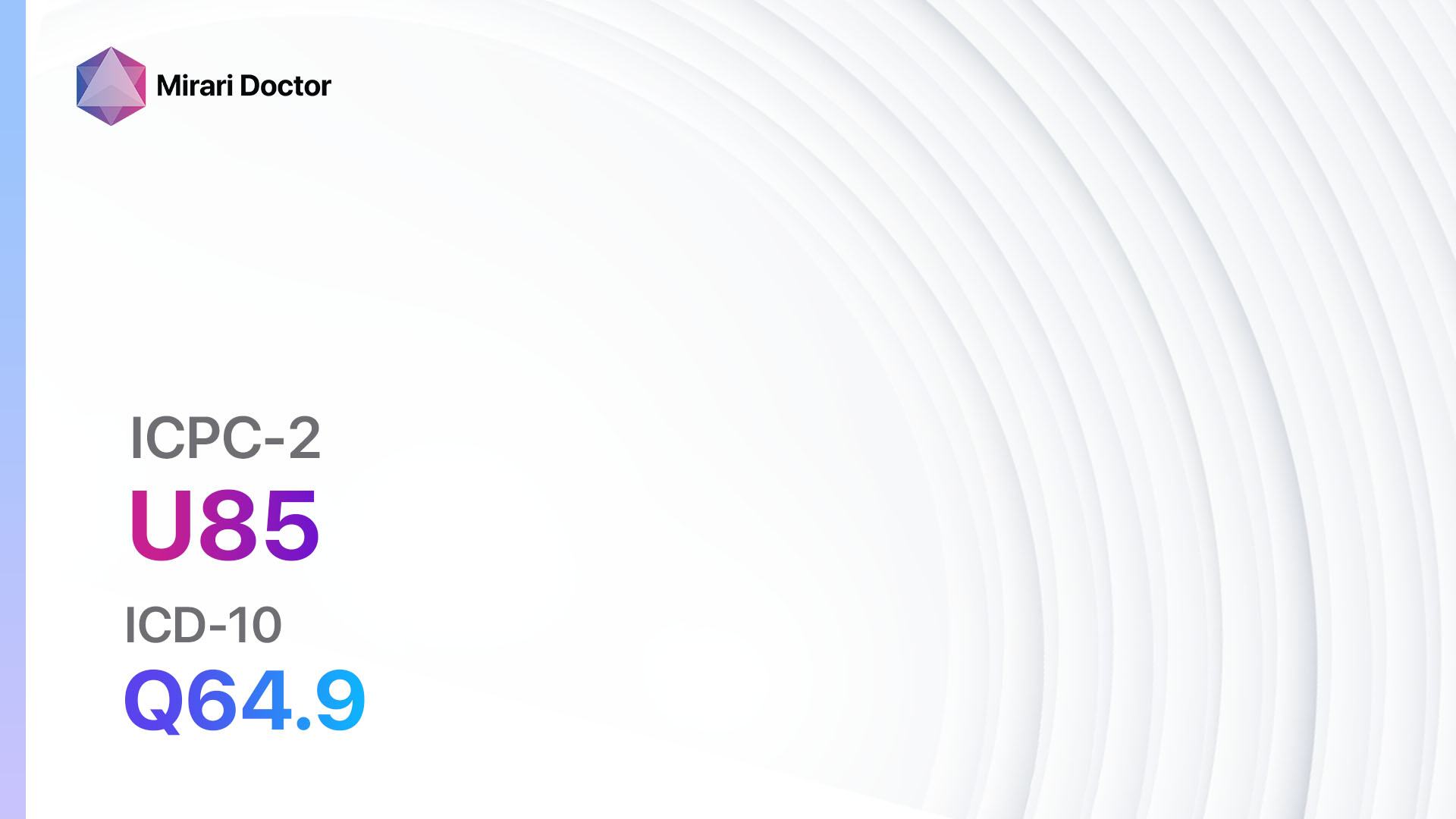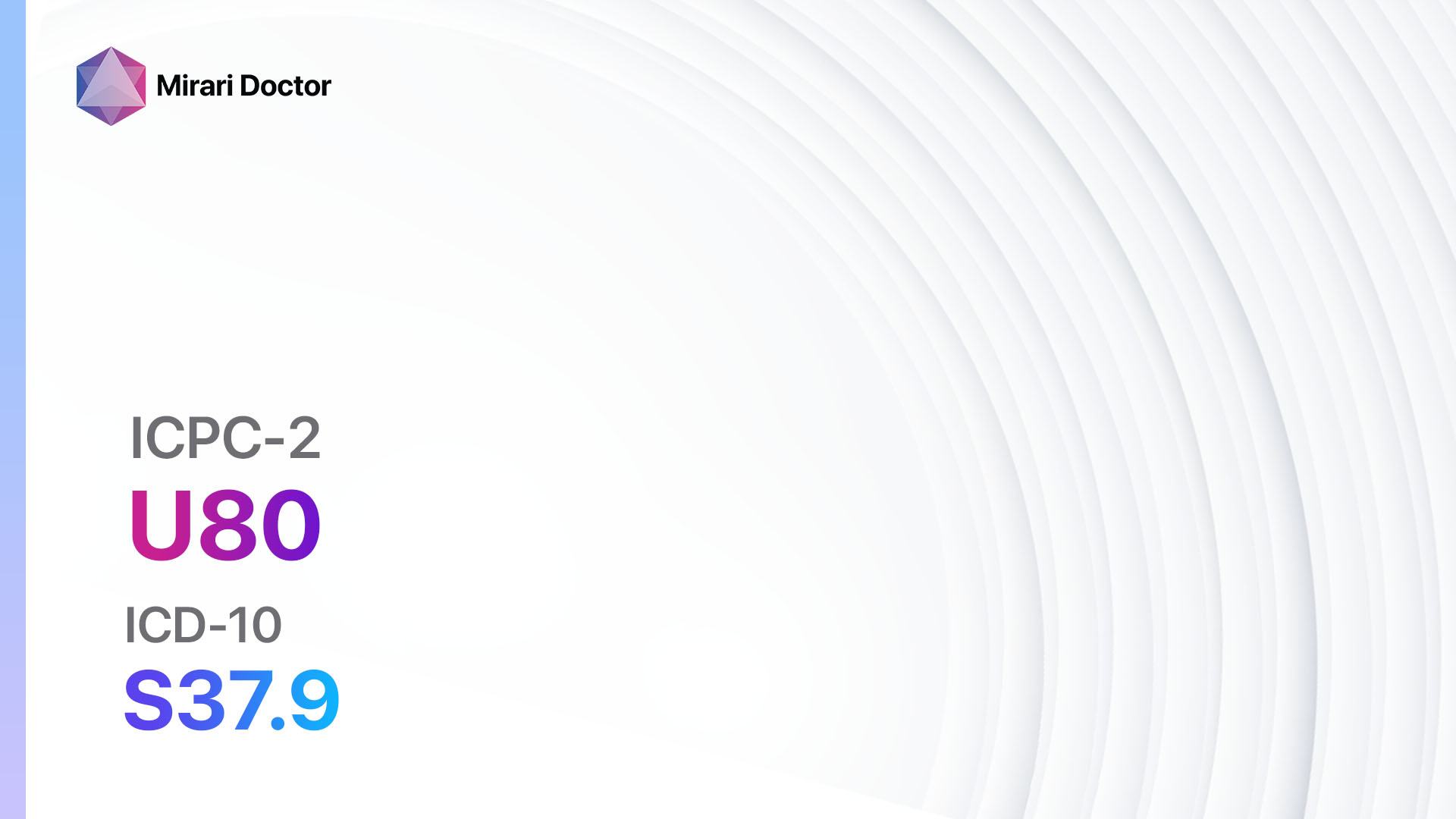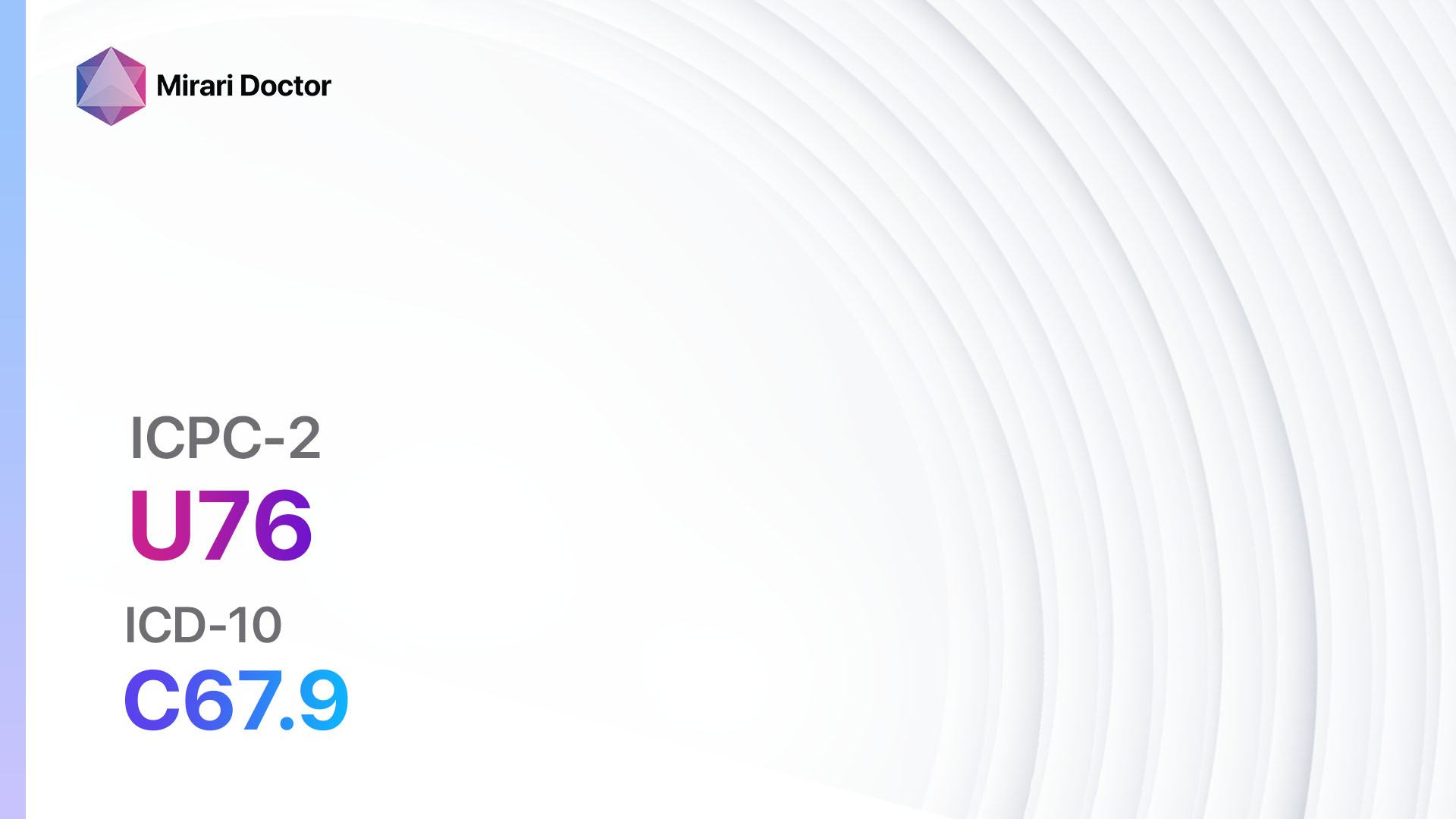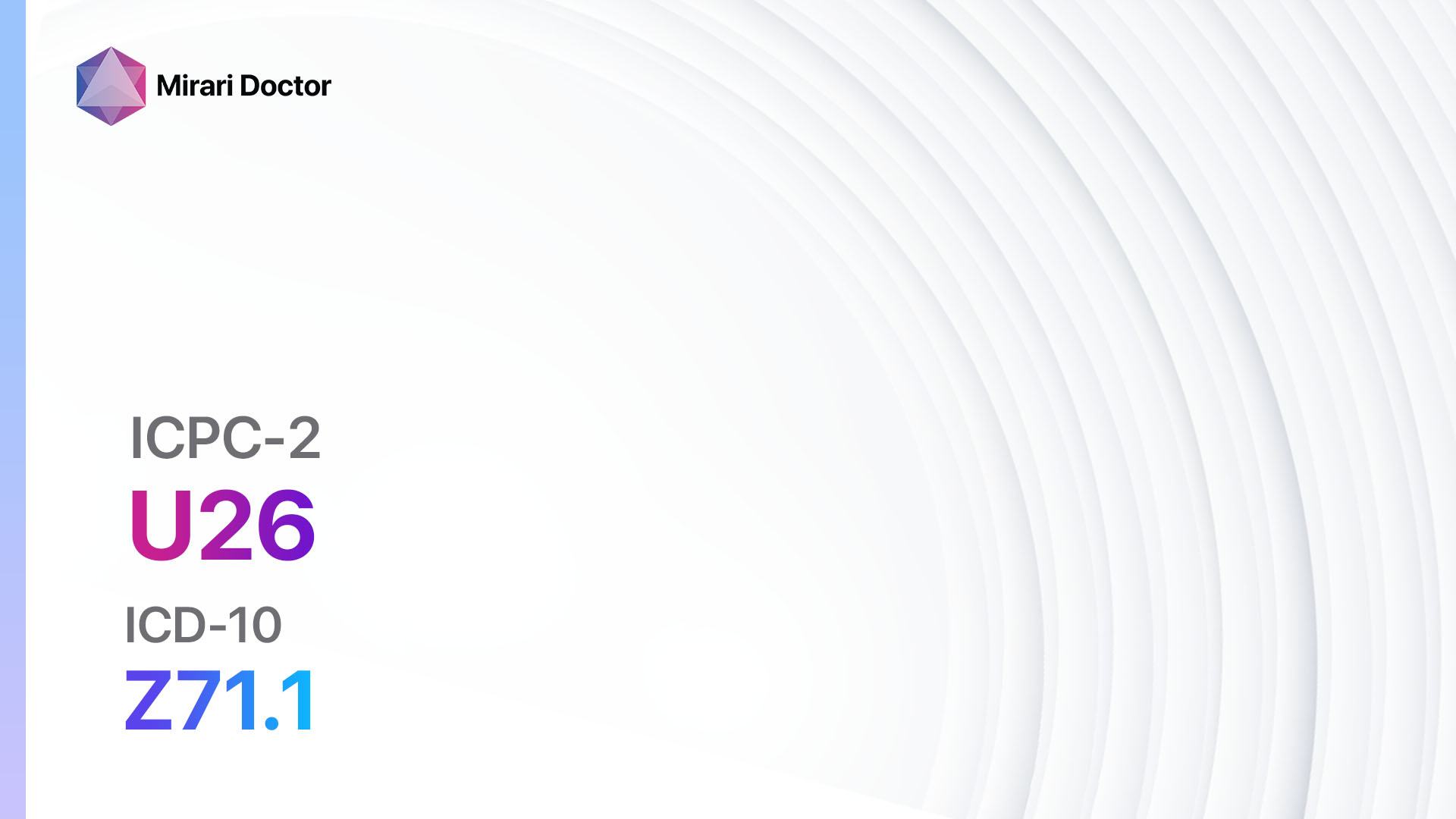
Introduction
Urine symptom/complaint other refers to any urinary symptoms or complaints that do not fall under specific diagnostic categories. These symptoms can include urinary frequency, urgency, nocturia, dysuria, hematuria, or any other abnormal urinary symptoms[1]. It is important to evaluate and diagnose the underlying cause of these symptoms to provide appropriate treatment and management. This guide aims to outline the diagnostic steps, possible interventions, and lifestyle modifications for urine symptom/complaint other.
Codes
- ICPC-2 Code: U07 Urine symptom/complaint other
- ICD-10 Code: R39.8 Other specified symptoms and signs involving the urinary system
Symptoms
- Urinary frequency: Increased need to urinate more often than usual.
- Urinary urgency: Sudden and strong urge to urinate.
- Nocturia: Waking up during the night to urinate.
- Dysuria: Pain or discomfort during urination.
- Hematuria: Blood in the urine[2].
Causes
- Urinary tract infection (UTI): Bacterial infection in the urinary tract.
- Bladder or kidney stones: Hard deposits that form in the bladder or kidneys.
- Prostate problems: Enlarged prostate or prostate infection.
- Interstitial cystitis: Chronic inflammation of the bladder.
- Urinary incontinence: Involuntary leakage of urine.
- Medications: Certain medications can cause urinary symptoms.
- Other medical conditions: Diabetes, neurological disorders, or bladder cancer[3].
Diagnostic Steps
Medical History
- Gather information about the patient’s symptoms, including the duration, severity, and any associated factors.
- Ask about any previous urinary tract infections, kidney stones, or bladder problems.
- Inquire about the patient’s medical history, including any chronic conditions or medications.
- Assess for any risk factors, such as diabetes or neurological disorders[4].
Physical Examination
- Perform a thorough physical examination, including a pelvic examination for women and a rectal examination for men.
- Check for any signs of infection, such as fever or tenderness in the lower abdomen.
- Palpate the abdomen to assess for any masses or enlarged organs.
- Evaluate the genitalia and perineum for any abnormalities[5].
Laboratory Tests
- Urinalysis: Analyze a urine sample for the presence of blood, infection, or other abnormalities.
- Urine culture: Identify any bacterial growth in the urine to diagnose a urinary tract infection.
- Blood tests: Measure kidney function, electrolyte levels, and blood glucose levels[6].
- Imaging studies: In some cases, imaging studies may be necessary to evaluate the urinary tract further.
Diagnostic Imaging
- Ultrasound: Non-invasive imaging technique to visualize the kidneys, bladder, and urinary tract.
- CT scan: Provides detailed images of the urinary tract to identify any abnormalities or stones.
- MRI: Useful for evaluating the kidneys, bladder, and surrounding structures[7].
Other Tests
- Cystoscopy: A thin tube with a camera is inserted into the urethra to visualize the bladder and urethra.
- Urodynamic testing: Measures bladder and urethral function to assess for any abnormalities.
- Biopsy: In some cases, a tissue sample may be taken for further evaluation[8].
Follow-up and Patient Education
- Schedule a follow-up appointment to discuss the results of the diagnostic tests and determine the appropriate treatment plan.
- Provide patient education regarding the underlying cause of the symptoms, treatment options, and lifestyle modifications[9][10].
Possible Interventions
Traditional Interventions
Medications:
Top 5 drugs for urine symptom/complaint other:
- Antibiotics (e.g., Ciprofloxacin, Nitrofurantoin):
- Cost: Generic versions can be $3-$50/month.
- Contraindications: Hypersensitivity to the medication.
- Side effects: Nausea, diarrhea, allergic reactions.
- Severe side effects: Tendon rupture, severe allergic reactions.
- Drug interactions: Warfarin, antacids.
- Warning: Finish the full course of antibiotics as prescribed.
- Alpha-blockers (e.g., Tamsulosin, Alfuzosin):
- Cost: Generic versions can be $10-$50/month.
- Contraindications: Hypersensitivity to the medication, severe liver disease.
- Side effects: Dizziness, low blood pressure, retrograde ejaculation.
- Severe side effects: Priapism (prolonged erection), allergic reactions.
- Drug interactions: Other alpha-blockers, nitrates.
- Warning: Take the medication as prescribed and avoid sudden position changes.
- Anticholinergic medications (e.g., Oxybutynin, Tolterodine):
- Cost: Generic versions can be $10-$50/month.
- Contraindications: Glaucoma, urinary retention, gastrointestinal obstruction.
- Side effects: Dry mouth, constipation, blurred vision.
- Severe side effects: Urinary retention, confusion, hallucinations.
- Drug interactions: Other anticholinergic medications, opioids.
- Warning: Avoid activities that require mental alertness until the effects of the medication are known.
- Pain relievers (e.g., Ibuprofen, Acetaminophen):
- Cost: Generic versions can be $3-$10/month.
- Contraindications: Allergy to the medication, active gastrointestinal bleeding.
- Side effects: Upset stomach, headache, dizziness.
- Severe side effects: Severe allergic reactions, liver damage.
- Drug interactions: Blood thinners, other pain relievers.
- Warning: Take the medication as directed and avoid exceeding the recommended dosage.
- Hormone therapy (e.g., Estrogen, Testosterone):
- Cost: Varies depending on the specific hormone and formulation.
- Contraindications: History of hormone-sensitive cancer, blood clots.
- Side effects: Nausea, breast tenderness, mood changes.
- Severe side effects: Increased risk of certain cancers, blood clots.
- Drug interactions: Other hormone medications, certain antibiotics.
- Warning: Discuss the risks and benefits of hormone therapy with a healthcare provider.
Alternative Drugs:
- Phytotherapy (e.g., Saw palmetto, Cranberry extract): Herbal supplements that may help alleviate urinary symptoms.
- Antidepressants (e.g., Amitriptyline, Duloxetine): Can be used for certain types of chronic pelvic pain.
- Antispasmodic medications (e.g., Hyoscyamine, Dicyclomine): Help relieve bladder spasms and reduce urinary urgency.
Surgical Procedures:
- Transurethral resection of the prostate (TURP): Surgical removal of prostate tissue to alleviate urinary symptoms in men with an enlarged prostate. Cost: $10,000 to $20,000.
- Urethral dilation: Widening of the urethra to improve urine flow. Cost: $5,000 to $10,000.
- Bladder augmentation: Surgical procedure to increase the capacity of the bladder. Cost: $20,000 to $40,000.
Alternative Interventions
- Acupuncture: May help alleviate urinary symptoms and improve overall well-being. Cost: $60-$120 per session.
- Herbal supplements: Certain herbs, such as cranberry extract or saw palmetto, may have potential benefits for urinary symptoms. Cost: Varies depending on the specific supplement.
- Pelvic floor exercises: Strengthening the pelvic floor muscles can help improve bladder control. Cost: Free.
- Behavioral therapy: Techniques such as bladder training and scheduled voiding can help manage urinary symptoms. Cost: Varies depending on the therapist or program.
- Biofeedback: Using electronic devices to provide feedback and help control bladder function. Cost: $100-$200 per session.
Lifestyle Interventions
- Fluid management: Adjusting fluid intake, especially before bedtime, to reduce nocturia. Cost: Free.
- Dietary modifications: Avoiding bladder irritants such as caffeine, alcohol, and spicy foods. Cost: Varies depending on food choices.
- Weight management: Losing weight can help alleviate urinary symptoms, especially in cases of obesity. Cost: Varies depending on weight loss program or gym membership.
- Bladder training: Gradually increasing the time between bathroom visits to improve bladder control. Cost: Free.
- Stress management: Stress reduction techniques, such as meditation or yoga, can help manage urinary symptoms. Cost: Varies depending on the chosen method.
It is important to note that the cost ranges provided are approximate and may vary depending on the location and availability of the interventions. It is recommended to consult with a healthcare provider for a more accurate cost assessment and to determine the most suitable interventions for individual cases.
Mirari Cold Plasma Alternative Intervention
Understanding Mirari Cold Plasma
- Safe and Non-Invasive Treatment: Mirari Cold Plasma is a safe and non-invasive treatment option for various skin conditions. It does not require incisions, minimizing the risk of scarring, bleeding, or tissue damage.
- Efficient Extraction of Foreign Bodies: Mirari Cold Plasma facilitates the removal of foreign bodies from the skin by degrading and dissociating organic matter, allowing easier access and extraction.
- Pain Reduction and Comfort: Mirari Cold Plasma has a local analgesic effect, providing pain relief during the treatment, making it more comfortable for the patient.
- Reduced Risk of Infection: Mirari Cold Plasma has antimicrobial properties, effectively killing bacteria and reducing the risk of infection.
- Accelerated Healing and Minimal Scarring: Mirari Cold Plasma stimulates wound healing and tissue regeneration, reducing healing time and minimizing the formation of scars.
Mirari Cold Plasma Prescription
Video instructions for using Mirari Cold Plasma Device – U07 Urine symptom/complaint other (ICD-10:R39.8)
| Mild | Moderate | Severe |
| Mode setting: 1 (Infection) Location: 2 (Prostate & Uterus) Morning: 15 minutes, Evening: 15 minutes |
Mode setting: 1 (Infection) Location: 2 (Prostate & Uterus) Morning: 30 minutes, Lunch: 30 minutes, Evening: 30 minutes |
Mode setting: 1 (Infection) Location: 2 (Prostate & Uterus) Morning: 30 minutes, Lunch: 30 minutes, Evening: 30 minutes |
| Mode setting: 6 (Liver/Kidney Therapy) Location: 2 (Prostate & Uterus) Morning: 15 minutes, Evening: 15 minutes |
Mode setting: 6 (Liver/Kidney Therapy) Location: 2 (Prostate & Uterus) Morning: 30 minutes, Lunch: 30 minutes, Evening: 30 minutes |
Mode setting: 6 (Liver/Kidney Therapy) Location: 2 (Prostate & Uterus) Morning: 30 minutes, Lunch: 30 minutes, Evening: 30 minutes |
| Mode setting: 6 (Liver/Kidney Therapy) Location: 3 (Kidney, Liver & Spleen) Morning: 15 minutes, Evening: 15 minutes |
Mode setting: 6 (Liver/Kidney Therapy) Location: 3 (Kidney, Liver & Spleen) Morning: 30 minutes, Lunch: 30 minutes, Evening: 30 minutes |
Mode setting: 6 (Liver/Kidney Therapy) Location: 3 (Kidney, Liver & Spleen) Morning: 30 minutes, Lunch: 30 minutes, Evening: 30 minutes |
| Mode setting: 7 (Immunotherapy) Location: 1 (Sacrum) Morning: 15 minutes, Evening: 15 minutes |
Mode setting:7 (Immunotherapy) Location: 1 (Sacrum) Morning: 30 minutes, Lunch: 30 minutes, Evening: 30 minutes |
Mode setting:7 (Immunotherapy) Location: 1 (Sacrum) Morning: 30 minutes, Lunch: 30 minutes, Evening: 30 minutes |
| Total Morning: 60 minutes approx. $10 USD, Evening: 60 minutes approx. $10 USD |
Total Morning: 120 minutes approx. $20 USD, Lunch: 120 minutes approx. $20 USD, Evening: 120 minutes approx. $20 USD, |
Total Morning: 120 minutes approx. $20 USD, Lunch: 120 minutes approx. $20 USD, Evening: 120 minutes approx. $20 USD, |
| Usual treatment for 7-60 days approx. $140 USD – $1200 USD | Usual treatment for 6-8 weeks approx. $2,520 USD – $3,360 USD |
Usual treatment for 3-6 months approx. $5,400 USD – $10,800 USD
|
 |
|
Use the Mirari Cold Plasma device to treat Urine symptom/complaint other effectively.
WARNING: MIRARI COLD PLASMA IS DESIGNED FOR THE HUMAN BODY WITHOUT ANY ARTIFICIAL OR THIRD PARTY PRODUCTS. USE OF OTHER PRODUCTS IN COMBINATION WITH MIRARI COLD PLASMA MAY CAUSE UNPREDICTABLE EFFECTS, HARM OR INJURY. PLEASE CONSULT A MEDICAL PROFESSIONAL BEFORE COMBINING ANY OTHER PRODUCTS WITH USE OF MIRARI.
Step 1: Cleanse the Skin
- Start by cleaning the affected area of the skin with a gentle cleanser or mild soap and water. Gently pat the area dry with a clean towel.
Step 2: Prepare the Mirari Cold Plasma device
- Ensure that the Mirari Cold Plasma device is fully charged or has fresh batteries as per the manufacturer’s instructions. Make sure the device is clean and in good working condition.
- Switch on the Mirari device using the power button or by following the specific instructions provided with the device.
- Some Mirari devices may have adjustable settings for intensity or treatment duration. Follow the manufacturer’s instructions to select the appropriate settings based on your needs and the recommended guidelines.
Step 3: Apply the Device
- Place the Mirari device in direct contact with the affected area of the skin. Gently glide or hold the device over the skin surface, ensuring even coverage of the area experiencing.
- Slowly move the Mirari device in a circular motion or follow a specific pattern as indicated in the user manual. This helps ensure thorough treatment coverage.
Step 4: Monitor and Assess:
- Keep track of your progress and evaluate the effectiveness of the Mirari device in managing your Urine symptom/complaint other. If you have any concerns or notice any adverse reactions, consult with your health care professional.
Note
This guide is for informational purposes only and should not replace the advice of a medical professional. Always consult with your healthcare provider or a qualified medical professional for personal advice, diagnosis, or treatment. Do not solely rely on the information presented here for decisions about your health. Use of this information is at your own risk. The authors of this guide, nor any associated entities or platforms, are not responsible for any potential adverse effects or outcomes based on the content.
Mirari Cold Plasma System Disclaimer
- Purpose: The Mirari Cold Plasma System is a Class 2 medical device designed for use by trained healthcare professionals. It is registered for use in Thailand and Vietnam. It is not intended for use outside of these locations.
- Informational Use: The content and information provided with the device are for educational and informational purposes only. They are not a substitute for professional medical advice or care.
- Variable Outcomes: While the device is approved for specific uses, individual outcomes can differ. We do not assert or guarantee specific medical outcomes.
- Consultation: Prior to utilizing the device or making decisions based on its content, it is essential to consult with a Certified Mirari Tele-Therapist and your medical healthcare provider regarding specific protocols.
- Liability: By using this device, users are acknowledging and accepting all potential risks. Neither the manufacturer nor the distributor will be held accountable for any adverse reactions, injuries, or damages stemming from its use.
- Geographical Availability: This device has received approval for designated purposes by the Thai and Vietnam FDA. As of now, outside of Thailand and Vietnam, the Mirari Cold Plasma System is not available for purchase or use.
References
- Michels, T. C., & Sands, J. E. (2015). Dysuria: Evaluation and Differential Diagnosis in Adults. American Family Physician, 92(9), 778-786.
- Grabe, M., Bartoletti, R., Bjerklund Johansen, T. E., Cai, T., Çek, M., Köves, B., … & Wagenlehner, F. (2015). Guidelines on urological infections. European Association of Urology, 182.
- Flores-Mireles, A. L., Walker, J. N., Caparon, M., & Hultgren, S. J. (2015). Urinary tract infections: epidemiology, mechanisms of infection and treatment options. Nature Reviews Microbiology, 13(5), 269-284.
- Bent, S., Nallamothu, B. K., Simel, D. L., Fihn, S. D., & Saint, S. (2002). Does this woman have an acute uncomplicated urinary tract infection?. Jama, 287(20), 2701-2710.
- Gupta, K., Hooton, T. M., Naber, K. G., Wullt, B., Colgan, R., Miller, L. G., … & Soper, D. E. (2011). International clinical practice guidelines for the treatment of acute uncomplicated cystitis and pyelonephritis in women: a 2010 update by the Infectious Diseases Society of America and the European Society for Microbiology and Infectious Diseases. Clinical Infectious Diseases, 52(5), e103-e120.
- Schaeffer, A. J., & Schaeffer, E. M. (2012). Infections of the urinary tract. Campbell-Walsh Urology, 10, 257-326.
- Nicolle, L. E. (2008). Uncomplicated urinary tract infection in adults including uncomplicated pyelonephritis. Urologic Clinics of North America, 35(1), 1-12.
- Stamm, W. E., & Norrby, S. R. (2001). Urinary tract infections: disease panorama and challenges. The Journal of Infectious Diseases, 183(Supplement_1), S1-S4.
- Foxman, B. (2002). Epidemiology of urinary tract infections: incidence, morbidity, and economic costs. The American Journal of Medicine, 113(1), 5-13.
- Hooton, T. M. (2012). Uncomplicated urinary tract infection. New England Journal of Medicine, 366(11), 1028-1037.
Related articles
Made in USA



























